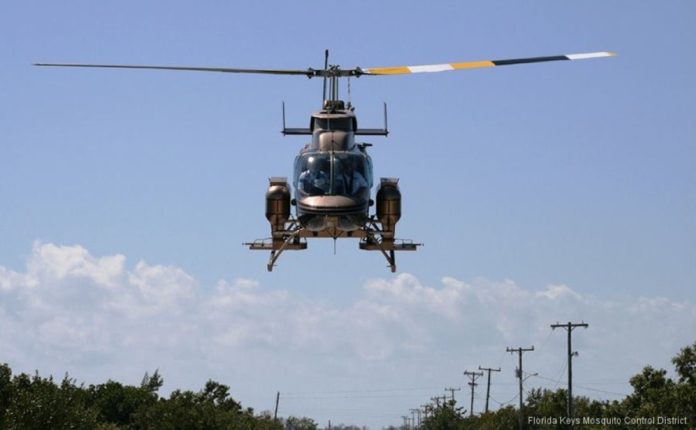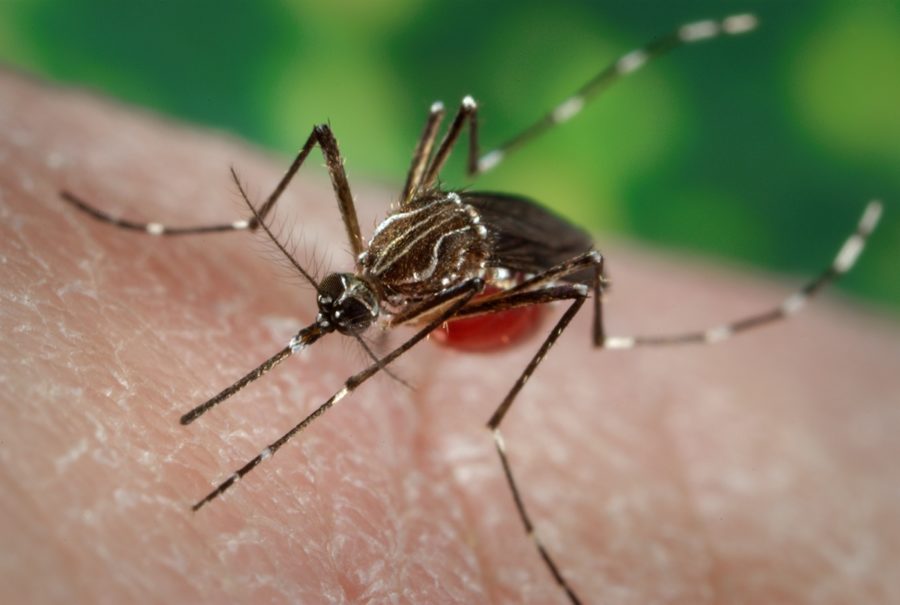
More confirmed dengue fever cases in Key Largo have brought the total number of infected to 16. Meanwhile, the Florida Keys Mosquito Control District is intensifying its efforts via air and ground in the Upper Keys to thwart potential breeding sites.
Health officials say they received laboratory confirmation of three additional cases on July 11 and two more on July 17. All indications are that they were locally acquired. The individuals have received medical treatment and are expected to make a full recovery, according to the health department.
Dengue fever is a mosquito-borne tropical disease caused by the dengue virus that presents severe flu-like symptoms, muscle aches and pain, fever and rash in some cases.
Health officials say there are usually no respiratory symptoms associated with the illness. Symptoms usually appear 10-14 days after a bite from an infected mosquito.
A female resident of Key Largo, who wished to remain anonymous, said she had beginning symptoms on a Monday. By Tuesday evening, she was down for the rest of the week with body aches and no appetite. It’s taken two full weeks before she started to feel like herself.
“I would never wish dengue on anyone,” she told the Weekly. “It was the sickest I have been in a very long time.”
Dr. Tom Morrison, of Mariners and Fishermen’s hospitals and Advanced Urgent Care in Key Largo, said Monroe County saw its first case of dengue early in the year at MM 99, bayside, in Key Largo. The individual was an isolated case and made a full recovery.
“We started to see more cases in June from Harry Harris to MM 106,” Morrison said.
Dengue fever is not contagious. It is transmitted by the bite of an infected Aedes aegypti mosquito — one of the most common container-breeding mosquitoes in the Keys. They can be found breeding in artificial containers such as trash cans, flower pots and birdbaths. The mosquito is a vector of other various diseases including Zika, Chikungunya and yellow fever.
Most dengue virus infections produce mild, nonspecific symptoms or classic dengue fever. Severe dengue, dengue hemorrhagic fever (DHF)/dengue shock syndrome (DSS), occurs in less than 1% of all dengue virus infections. Morrison said dengue fever has four serotypes (particular virus strains): DENV-1, DENV-2, DENV-3, DENV-4.
“The bad one is DENV-2,” Morrison said. “Currently, we have DENV-1 in Florida.”
On the operations side, Florida Keys Mosquito Control District is continuing its air and ground attack to limit breeding possibilities. Thanks to approval by the local school board, mosquito control is using the Key Largo School grounds as a temporary landing and loading zone.
With use of the site, mosquito control can maximize its time in the area providing mosquito treatments as opposed to flying to and from regular landing zones, which are miles away. All efforts are being made to minimize any disruption to summer school functions and other activities.
It is estimated that FKMCD helicopters will use the school property approximately two times per week during the next four to six weeks. FKMCD is also using the field to refill the helicopter with a liquid larvicide product that is being utilized to thwart breeding sites of the Aedes aegypti mosquito. A liquid larvicide mission took place during the early mornings of July 14 and 15.
“FKMCD has been extremely active between MM 98 and 106.5,” said Chad Huff, public information officer for FKMCD.
The liquid larvicide utilized by the district is a form of Bti, or Bacillus thuringiensis israelensis, which is a naturally occurring soil bacterium mixed with water and applied as a fine mist. Bti has no effect on non-target organisms when used in the manner employed by FKMCD.

In addition to the aerial larvicide missions, FKMCD continues its enhanced Key Largo dengue response, which includes door-to-door canvassing by FKMCD inspectors to help eliminate mosquito breeding sites and aerial and ground spraying for adult mosquitoes. Inspectors were in Harry Harris earlier in the week checking properties for standing water.
“FKMCD is committed to protecting public health, and to that end, will dedicate whatever resources are necessary to bring the dengue situation under control,” Huff said.
The emergence of these dengue cases is reinforcing the importance for the public to prevent insect bites and to take basic precautions to help limit exposure. These measures include intact windows and screens and the use of air conditioning, keeping the area around homes free from containers that collect water, wearing protective clothing and theappropriate use of insect repellents.
More information is at www.floridahealth.gov/dengue or www.keysmosquito.org. Those who are experiencing any symptoms or have additional questions are asked to call DOH-Monroe at 305-293-7500 and choose option 3.





















